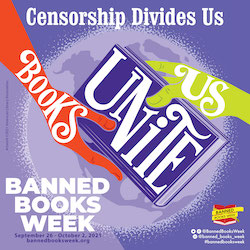The History and Importance of Banned Books Week
2021’s Banned Books Week promotes unity and reminds readers of the First Amendment.
October 1, 2021
A banned book is one that, although it is still publicly accessible, is removed from school curriculums or libraries. Some books that have been challenged are To Kill a Mockingbird and Of Mice and Men, both challenged for racial slurs and overall negative effects on children.

In 1982, there was a surge of challenging books that had been placed in libraries and schools. Notably, the Island Trees School District v. Pico court case ruled that content is not a justifiable enough reason to ban books in libraries.
In response to the increased controversy of the topic, banned books week was launched.
Starting September 26 and ending October 2, 2021’s banned books week is a celebration of the freedom one has to read; it is also a reminder of the importance of the First Amendment.
Banned Books week encourages readers everywhere to procure titles that have previously provoked discourse. Its aim is to prove the harmful effects of censorship and explain their belief that banning books does more harm than good.
The public events for this year’s week are a Dear Banned Author Letter-Writing Campaign and a Stand for the Banned Read-Out, which encourages people to show their appreciation for all types of literature—controversial and not.

This year’s theme for the week is “Books Unite Us. Censorship Divides Us.”








